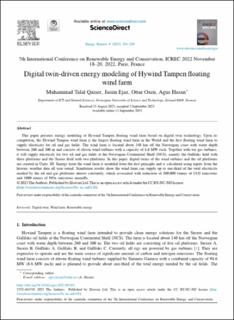| dc.contributor.author | Qaiser, Muhammad Talal | |
| dc.contributor.author | Ejaz, Jasim | |
| dc.contributor.author | Osen, Ottar Laurits | |
| dc.contributor.author | Hasan, Agus Ismail | |
| dc.date.accessioned | 2024-01-12T11:50:33Z | |
| dc.date.available | 2024-01-12T11:50:33Z | |
| dc.date.created | 2023-10-04T12:47:16Z | |
| dc.date.issued | 2023 | |
| dc.identifier.issn | 2352-4847 | |
| dc.identifier.uri | https://hdl.handle.net/11250/3111289 | |
| dc.description.abstract | This paper presents energy modeling of Hywind Tampen floating wind farm based on digital twin technology. Upon its completion, the Hywind Tampen wind farm is the largest floating wind farm in the World and the first floating wind farm to supply electricity for oil and gas fields. The wind farm is located about 140 km off the Norwegian coast with water depth between 260 and 300 m and consists of eleven wind turbines with a capacity of 8.6 MW each. Together with ten gas turbines, it will supply electricity for two oil and gas fields at the Norwegian Continental Shelf (NCS), namely the Gullfaks field with three platforms and the Snorre field with two platforms. In this paper, digital twins of the wind turbines and the oil platforms are created in Unity 3D. Energy from the wind farm is modeled from the first principle and is calculated using inputs from the historic weather data all year round. Simulation results show the wind farm can supply up to one-third of the total electricity needed by the oil and gas platforms almost constantly, which associated with reduction of 200,000 tonnes of CO2 emissions and 1000 tonnes of NOx emissions annually. | en_US |
| dc.language.iso | eng | en_US |
| dc.publisher | Elsevier B. V. | en_US |
| dc.rights | Attribution-NonCommercial-NoDerivatives 4.0 Internasjonal | * |
| dc.rights.uri | http://creativecommons.org/licenses/by-nc-nd/4.0/deed.no | * |
| dc.title | Digital twin-driven energy modeling of Hywind Tampen floating wind farm | en_US |
| dc.title.alternative | Digital twin-driven energy modeling of Hywind Tampen floating wind farm | en_US |
| dc.type | Peer reviewed | en_US |
| dc.type | Journal article | en_US |
| dc.description.version | publishedVersion | en_US |
| dc.source.pagenumber | 284-289 | en_US |
| dc.source.volume | 9 suppl. 11 | en_US |
| dc.source.journal | Energy Reports | en_US |
| dc.identifier.doi | 10.1016/j.egyr.2023.09.023 | |
| dc.identifier.cristin | 2181622 | |
| cristin.ispublished | true | |
| cristin.fulltext | original | |
| cristin.qualitycode | 1 | |

